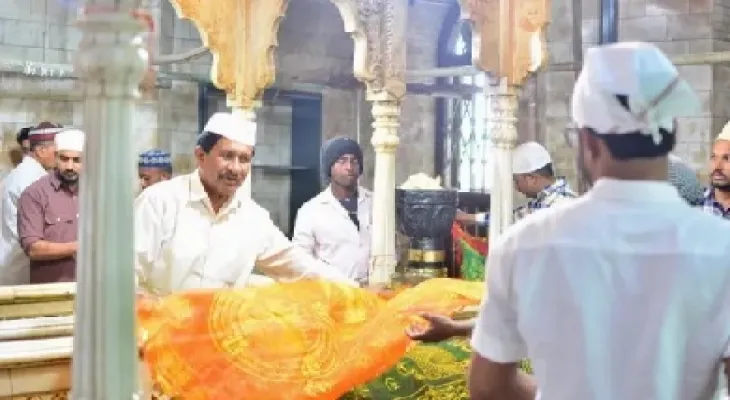Search here
Newspaper
Search here

Arab Canada News
News

Published: January 31, 2024
A Sufi shrine frequented by Indians of all religions has recently made headlines after a major political leader said he wanted to "liberate" it for Hindus only. BBC correspondent Sherilyn Mullan visited the site to understand the reasons behind the controversy.
The ascent was not easy, with about 1,500 steps carved into the rock separating visitors from their destination: the tomb of a Sufi saint that has become a site of faith, mythology, and contested history.
It is said that the shrine of "Haji Malang Darga," located on a hill in the suburbs of Mumbai in the western state of Maharashtra, houses the grave of an Arab missionary who came to India over 700 years ago. Like many other Sufi shrines across India, it is seen as a symbol of integration and tolerance, despite being at the heart of a "religious conflict."
When I visited the shrine, both Hindus and Muslims were offering flowers and chadars—a piece of cloth presented as a symbol of respect in Sufi traditions—at the saint’s grave. There is a prevailing belief that any wish made with a "pure heart" will be fulfilled.
The shrine’s management reflects this spirit of coexistence—in that while two of the shrine’s trustees are Muslim, its successors come from a Hindu family.
But earlier this month, the Chief Minister of Maharashtra state, Eknath Shinde, sparked controversy by making a decades-old claim at a political rally, affirming that the structure was originally a Hindu temple and declaring his commitment to "liberate" it.
Shinde did not respond to BBC’s request for comment.
His claim comes at a time when some prominent mosques and Islamic monuments in India are engulfed in disputes over allegations that they were built by demolishing Hindu temples centuries ago.
In the 1980s, Anand Dighe, Shinde’s political mentor, led a campaign to "reclaim" the Haji Malang Darga for Hindus. In 1996, he reportedly led 20,000 workers from the Shiv Sena party inside the darga to perform puja (a Hindu worship ritual).
Since then, Hindu hardliners, who refer to the structure as Malangjad, have continued to perform puja in the shrine on full moon days, sometimes leading to clashes with Muslim worshippers and local residents.
But political observers say Shinde’s stance may have little to do with faith, and Dighe’s campaign boosted his popularity among Hindu voters in Maharashtra.
Prashant Dixit, a former journalist, says, "Shinde is now trying to present himself as the Hindu savior of Maharashtra."
Separate from national elections, the state of Maharashtra—the richest state in India—will vote later this year to elect its state assembly. Dixit says securing support from the Hindu majority is crucial for Shinde, given the state’s distinctive political landscape.
Elections in Maharashtra are usually a four-way contest among the Hindu nationalist Shiv Sena party, the Bharatiya Janata Party (BJP), the centrist Nationalist Congress Party, and the Congress.
But Shinde faces an added complexity, having split from the Shiv Sena along with his supporters in 2022.
The "rebellion" toppled the then tripartite government—a surprising coalition of Shiv Sena, Congress, and the Nationalist Congress Party—and formed a new alliance with the BJP to establish the new government.
Dixit says, "While legislators may switch parties, it is difficult to convince core voters to change their loyalties," adding, "By stirring the darga issue, Shinde hopes to court the sentiments of core Shiv Sena voters and increase votes he gets from Hindu voters."
Hindus I spoke to for the BBC had mixed reactions to Shinde’s comments.
For example, Kushal Meshal believes Shinde is expressing what many have long thought—that the shrine originally belonged to a Hindu saint and was later taken over by Muslims during India’s invasions.
Rajendra Jaikwad shares a similar view but says he feels uneasy about the ongoing controversy, stating, "Everything happening in India now is very bad," affirming his belief that "all gods are one to him."
Abhijeet Nagari, who visits the shrine every month, says he doesn’t care about the religion to which the structure belongs—he loves visiting because he feels peace there.
Naseer Khan, one of the shrine trustees, told the BBC that the controversy has led to a decline in the number of worshippers visiting the shrine, adding, "People come with their families and don’t want to be disturbed by hooligans."
The structure, located atop a hill 3000 feet (914 meters) high, does not stand alone; houses, shops, and restaurants carved into stone and rocks have been added over the years.
Khan says about 4,000 people, both Hindus and Muslims, live there, and locals rely on tourism to earn their living, but "life is hard."
Local residents told the BBC they struggle to access basic amenities, such as potable water, especially during the harsh summer months.
Ayub Shaikh, a member of the local village council, says, "Water must be rationed, with each family getting only 10 liters of water per day."
There is also no proper hospital, school, or ambulance on the hill.
Shaikh, a 22-year-old auto-rickshaw driver who asked to use only his first name, says, "An educated person does not want to live here; there is nothing for them to do."
He adds, "All politicians want is to play tricks to get voters’ support; no one really cares about what the people want."
Many local residents echoed this sentiment.
Shaikh says, "Hindus and Muslims have lived harmoniously on this hill for centuries; we celebrate festivals together and support each other in times of need."
He adds, "No one stands with us, so why should we fight among ourselves?"
Comments